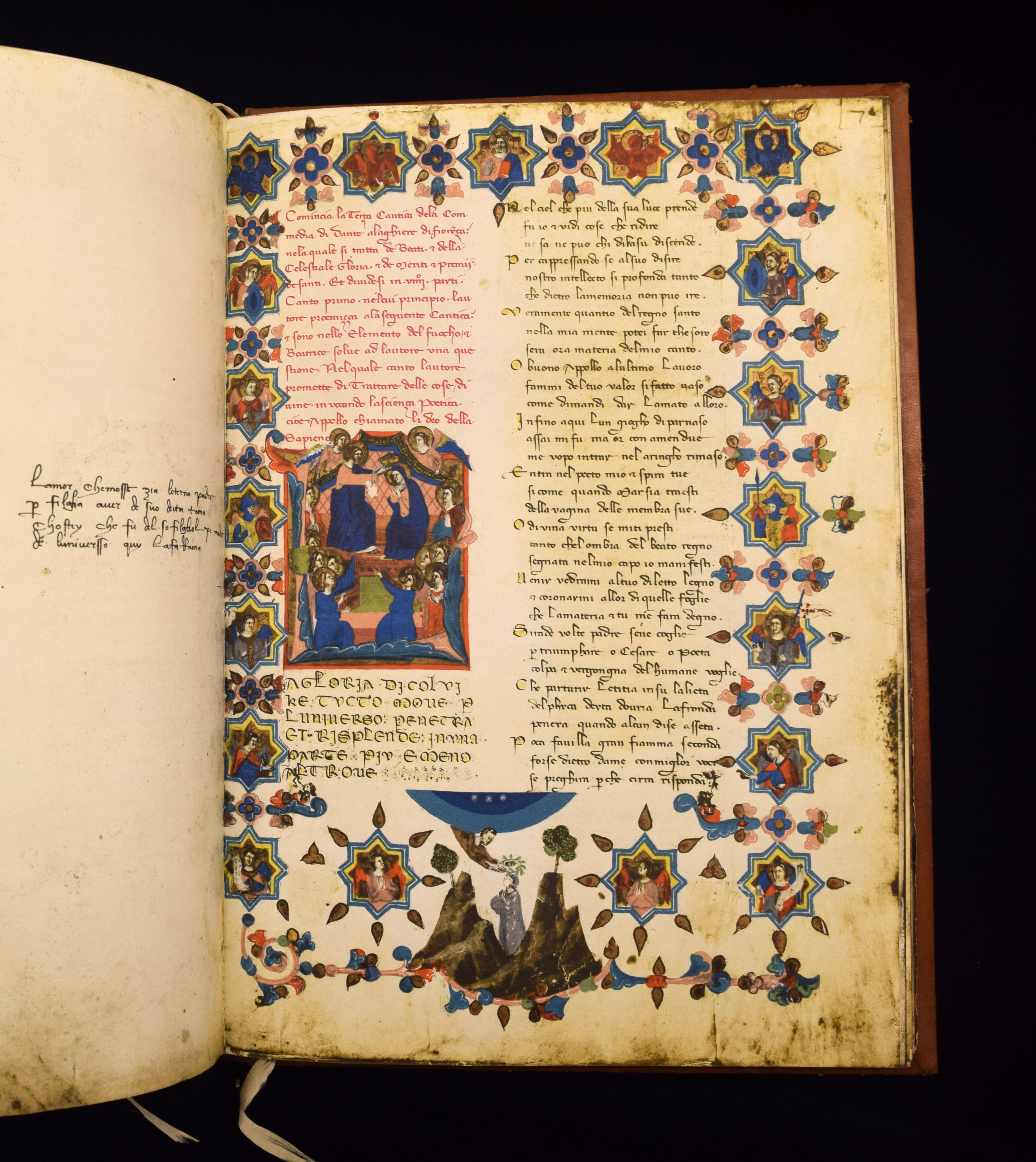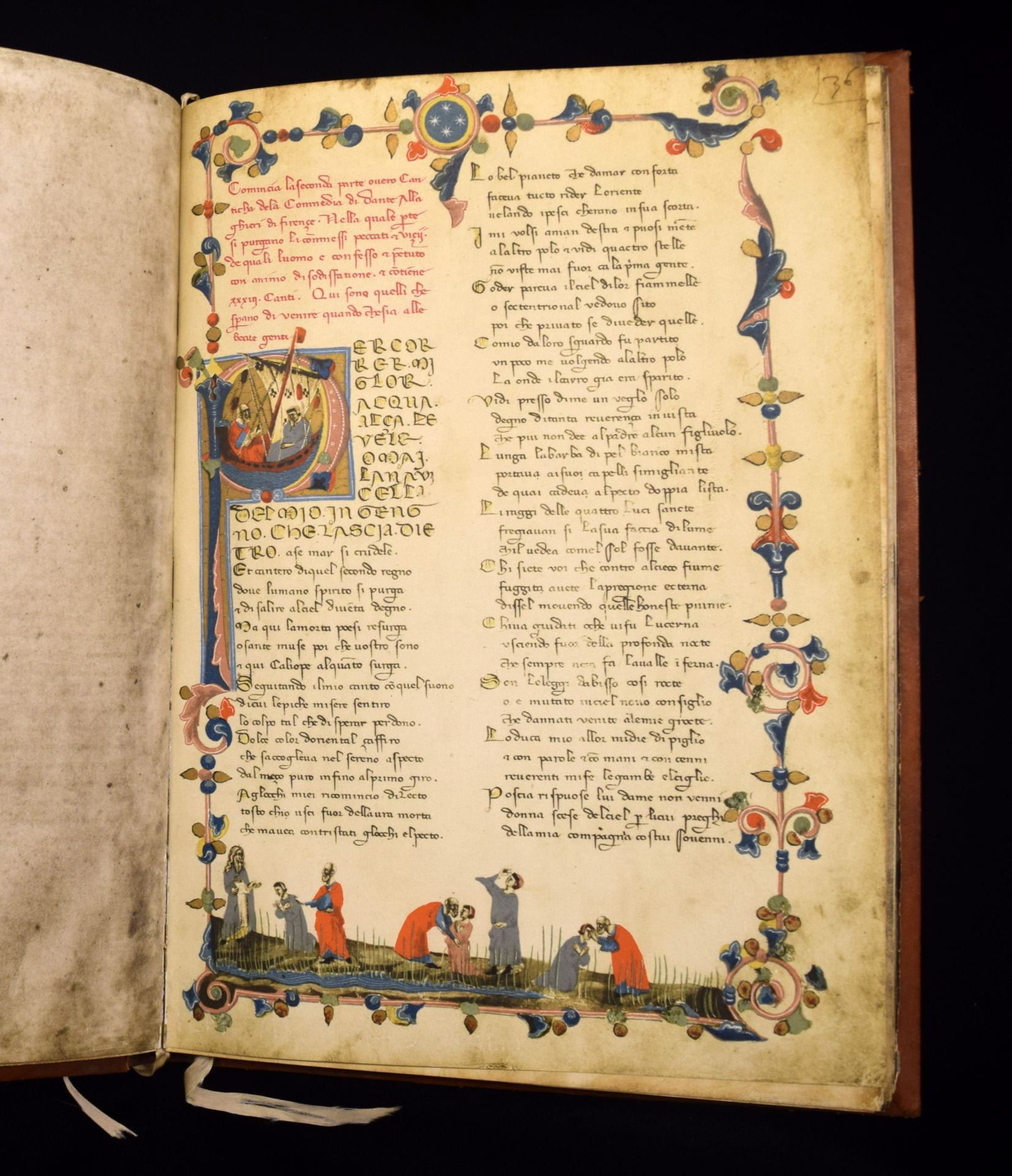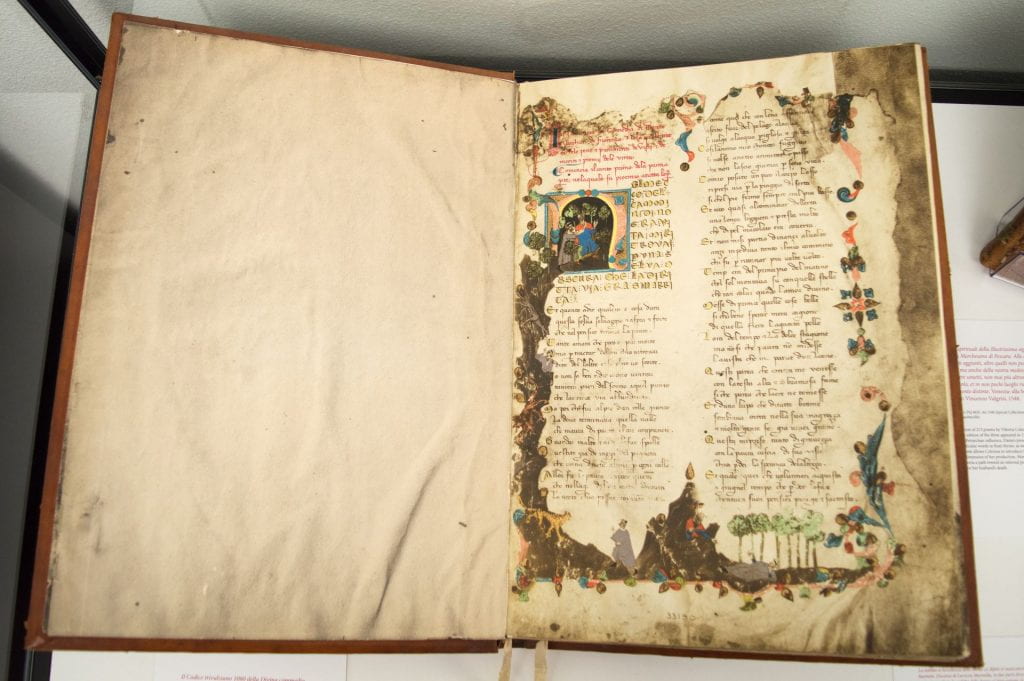Il Codice trivulziano 1080 della Divina commedia, riprodotto in eliocromia sotto gli auspici della Sezione milanese della Società dantesca italiana nel sesto centenario della morte del poeta con cenni storici e descrittivi di Luigi Rocca. Milano: Ulrico Hoepli, 1921.
Call number: Z115z .D2T (Special Collections)
Case 2: “Illustrations of the Divine Comedy and its Legacy Throughout the Centuries”
[Translation of the title in English: “1080 Trivulzian Code of the Divine Comedy, reproduced in heliochromy under the auspices of the Milanese Section of the Italian Dante Society on the sixth centenary of the poet’s death, with historical and descriptive notes by Luigi Rocca”]
This edition is a 1921 facsimile of the “Codice Trivulziano 1080,” aka “Danti del cento,” preserved at the Biblioteca Trivulziana in Milan. Exactly one century ago, it was issued to mark the sixth centenary of the poet’s demise. The original manuscript, a parchment volume copied in 1337 by Francesco di ser Nardo da Barberino, is the most antique and well-preserved Florentine illustrated copy of the Divine Comedy. It presents rubricated letters in red and blue, an example of which you can see in the exhibited page showing rich illuminations of the first canto in Inferno. A short paragraph introduces the content of the canto, while a Latin sentence concludes each canticle.
The text, written in an elegant chancery-cursive script, is organized in two columns. Miniatures attributed to the anonymous Master of the Dominican Effigies accompany the written text. Since there are no autographed copies of Dante’s Divine Comedy, the manuscript tradition of the poem is fundamental to the reconstruction of the original text. The fact that this volume was produced and the text copied just sixteen years after the poet’s death in 1321 demonstrates how common the Divine Comedy was already at the time. The manuscript was probably in the Venetian territory as early as the fifteenth century. Later on, the marquis Gian Giacomo Trivulzio (1774-1831) acquired it at the time of the Napoleonic suppression of the region’s convents toward the beginning of the 1800s; the item was already part of his collection in 1823.
Vincenzo Borghini, also known for his 1582 revised edition of Boccaccio’s Decameron, gives an account of a tale about this manuscript’s origins. According to this story, a man copied one hundred copies of the Divine Comedy as a dowry gift for his daughters, which explains the name “Danti del cento” used to refer to this group of manuscripts. However, calligraphic studies seem not to support this account and rather attribute the Trivulziano codex to a different hand other than the one that copied the other manuscripts.
Students’ Assignment: Jason, Jack, Tucker
For this assignment, we described the illuminations at the beginning of Inferno, as well as transcribed and translated in English the captions introducing Purgatorio and Paradiso.
The images on the far left and below represent the introductory page in Inferno. The rich illuminations along the border of the page tell the summary of Canto 1 in Inferno going from right to left. The first scene is Dante awakening from his slumber to the introduction of Virgil. First the leopard visits Dante, then as the viewer ascends the page Dante is confronted by the lion and finally the she-wolf. The final image in the illumination is Virgil guiding Dante out of the dark wood. This image leads the reader directly to the beginning of the text. The passage in Medieval Italian reads, “Incomincia la comedia di Dante Alleghieri di Fiorença. Ne la quale tratta de le pene et punimenti de viçii et de meriti et premii de le virtù. Comincia il canto primo de la prima parte ne la quale fa proemio a tutta l’opera.” The translation in modern English reads, “Here begins the comedy by Dante Alighieri from Florence, wherein the pains and punishments of the vices are discussed, as well as the merits and rewards of virtues. Here begins the first canto of the first part which functions as a proem to the entire work.”
The image in the center is the introductory page in Purgatorio. The transcription of the passage is, “Commincia la seconda parte overo canticha de la comedia di Dante Allaghieri di Firençe. Nella quale parte si purgano li commessi peccati et viçii, de quali l’uomo e confesso e pentuto con animo di sodisfazione. Et contiene XXXIII canti. Qui sono quelli che sperano di venire quando che sia alle beate gente.” The translation in modern English reads, “Here begins the second part or canticle of the comedy by Dante Alighieri from Florence, wherein the committed sins and vices are purged, those that men confessed and repented with satisfied souls. And it contains 33 cantos. Here are those who hope to reach the blessed people whenever it is.”
The image on the far right is the introductory page from Paradiso. The transcription from Medieval Italian reads, “Comincia la terza cantica de la comedia di Dante Aleghiere di Fiorença. Ne la quale si tratta de beati et della celestiale gloria et de meriti et premii de santi. Et dividesi in VIIII parti. Canto primo nel cui principio l’autore proemiçça a la seguente cantica, et sono ne lo elemento del fuocho, et Beatrice solve ad lautore una questione. Nel quale canto l’autore promette di trattare delle cose divine invocando la sciença poetica, cioe Appollo chiamato li deo della Sapienza.” The translation into modern English reads, “Here begins the third canticle of the comedy by Dante Alighieri from Florence, wherein the blessed souls, the celestial glory, and the merits and awards of the saints are discussed. And it is divided into 9 parts. First canto, the beginning of which functions as a preface of this canticle, and is in the element of fire, and Beatrice solves an issue for the author. In this canto, the author promises to discuss the divine things evoking the poetic science, which is Apollos also known as the God of Wisdom.”
Inferno, introductory page.




